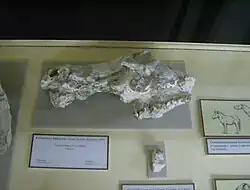Kalimantsia
Kalimantsia is an extinct chalicothere from the Miocene of Bulgaria, Europe. It contains one species, K. bulgarica.
| Kalimantsia Temporal range: Miocene | |
|---|---|
 | |
| Kalimantsia bulgarica, Asenovgrad Paleontological Museum | |
| Scientific classification | |
| Kingdom: | |
| Phylum: | |
| Class: | |
| Order: | |
| Family: | |
| Subfamily: | |
| Genus: | †Kalimantsia |
| Species: | †K. bulgarica |
| Binomial name | |
| †Kalimantsia bulgarica Geraads, Spassov & Kovachev, 2001 | |
Description
Kalimantsia is named for the area in which it was discovered in 2001 by Geraads, Spassov, and Kovachev. The habitat would have been quite open and the remains of Kalimantsia are accompanied by those of horses, early deer, and various carnivorous mammals. Kalimantsia has a shorter muzzle than the horse-like shapes of the rest of the chalicotheres. It also has a domed head that would have resembled those of pachycephalosaurs and the schizotheriine Tylocephalonyx. It is believed that males often competed by butting their heads together. The teeth of Kalimantsia are long and low, and well adapted for eating leaves.[1]
Size
- 3 m (10 ft.)[1]
See also
- Tylocephalonyx - Another genus of chalicothere that also has a domed head.
References
- Dixon, Dougal (2008). World Encyclopedia of Dinosaurs & Prehistoric Creatures. New York: Lorenz Books. pp. 453. ISBN 978-0-7548-1730-7.
This article is issued from Wikipedia. The text is licensed under Creative Commons - Attribution - Sharealike. Additional terms may apply for the media files.

